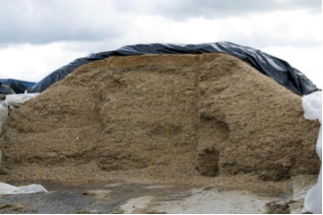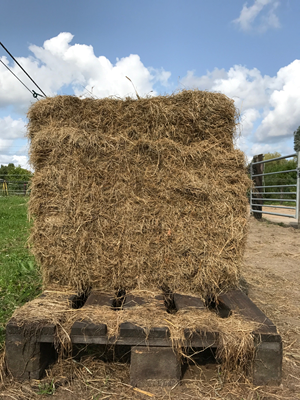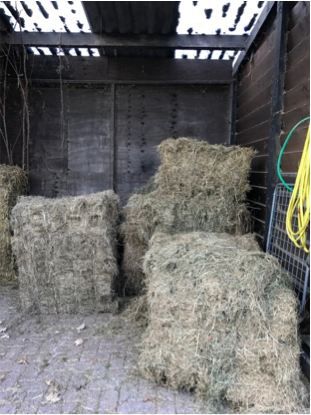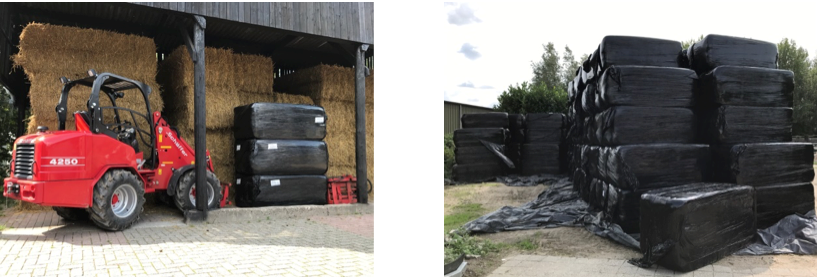A DIFFERENT VIEW ON HAY, HAYLAGE & SILAGE
Hay, herb hay, pre-dry, haylage, silage grass, grass silage, or just silage, there are so many names for this roughage ... All of them originated from the main component grass, but the big difference between the products hay, haylage and silage is in the preservation methods.
Roughage is important!
Roughage is the most important food for a horse to live on, because its entire digestive system is built on it. It is therefore also the case that a horse, fat or skinny, must be able to eat for at least 14 to 16 hours a day. This means that the quality of the roughage must be good, because what you put in will come out again! If you give poor roughage, your horse cannot function optimally and you will have all kinds of nutrition-related problems. In this blog I will therefore discuss what makes good roughage, such as the dry matter content, how it is made and the preservation processes and what is and what is not suitable for the horse.
Classification into three types of roughage on the dry matter content in%
Wikipedia: The dry matter content is a characteristic of many substances that naturally have a significant water content. The dry matter content is often shortened to dmb and it is expressed in percent by mass, or the mass of dry matter divided by the total mass of the substance.
1. Hay has 80-90% dry matter (dmb) content, because it has dried for 5 to 7 days.
2. Haylage 65-80%, this has dried for about 3 to 5 days. The term horse pit, pre-dry and silage grass also often refers to haylage.
3. Silage can only contain a content of 35-45% ds in the dairy farm and this silage comes from grass pits and can only have a field period of a maximum of 48 hours before it is ensiled.
So for cows it is called silage, for horses it is called pre-dry or haylage. Perhaps confusing but some haylage looks like hay. Hay is generally best to give to your horse. There is haylage out there that can be better in terms of nutrition than some batches of hay. The quality is what everything depends on, such as:
• the quality of the land from which it has been cut, such as the mineral content of the soil
• the time of mowing on the day
• what cut it is, so what time of the year
• the length of the grass and flowering or not
• the duration of drying
• the weather, heat, sun and wind
• the type of grass sown
• the possible variation of grass types and herbs in the grassland
• the method of fertilization and much more….
Good hay, haylage or making silage is quite an art!
Lactic and acetic acid in silage

Dry matter is the major control factor for the levels of lactic acid and acetic acid in silage. Lactic acid causes a pH drop in the silage and is therefore the determining factor in the conservation of silage. The higher the lactic acid content, the lower the pH, so the more acidic. The acetic acid coupled to lactic acid has an inhibiting effect on the development of scalding and fungi. The higher the acetic acid content, the lower the risk of scalding losses. Below 30% of dry matter, the contents will increase, but more butyric acid will also be formed, and rot bacteria will have a better chance.
Silage is usually not a suitable feed for horses, partly because it is usually also made from (somewhat shorter) production grass (English ryegrass) with a higher content of proteins and fructan. Potholes with a percentage of dry matter between 35 and 45% ensure sufficient acids and less forcing. This preserves more nutritional value and ensures higher milk production, but it is usually too sour and too rich for horses. For cows, molasses are also added to the silage by spraying it over it during production. When chopping, they often also add lactic acid or the molasses.
Haylage

Haylage is also called grass silage or pre-dry in the horse world and is a result of conservation through fermentation. As with hay, the grass is dried first, but less long. We speak of pre-drying that is suitable for horses if it contains at least about 60% dry matter. This product is popular in the Netherlands and Ireland, because we do not always have enough hours of sunshine to dry the grass completely as is done with hay. A characteristic of haylage is that it must always be packed airtight. As soon as the roughage is sealed airtight, good bacteria start converting sugars into, for example, lactic acid and acetic acid. Depending on the moisture content, the pH will drop until a stable value is reached. The acidic environment stops the growth of bacteria and the haylage becomes stable.
Haylage is actually dry silage or wet hay, therefore it must be packed more airtightly than silage. The acidification process takes a while and you cannot open the pack in between to see how the quality is. As a result, sometimes something goes wrong with a pack. It cannot be too dry, because it will mold. If it is too wet you will get silage and it is too acidic for horses. If there are other plants in it or things like bird droppings or a dead beast, the bale is also lost. As a farmer you can never know for sure how much dry matter it contains and it can differ per bale.
Hay!

Hay is preserved by drying and silage by acidification and haylage is exactly in between. You have long hay but also short hay and for horses grass with long stems, which is almost in bloom, is best. If you want to make hay from long grass, a farmer must also shake the hay more often when it is still on the land, at least 3x, but preferably more. And sun and warm weather is not enough, it also has to be windy. The trick is to get the hay into the bale as dry as possible to preserve it better and to prevent it to scald. In this process, aerobic bacteria convert useful nutrients into unwanted acids and the temperature of the hay rises. This can lead to the growth of unwanted bacteria, yeasts and fungi, which is a health risk for your horse.
The faster the grass dries, the better the hay is, otherwise the nutrients disappear. Hay takes a farmer more time to make and shaking several times also takes extra time and fuel. For the storage of hay you need a dry room, in contrast to haylage or silage. Therefore, hay is also more expensive. This cost and storage of hay not only determines the farmer, but also stable owners and horse owners. For many stables hay feeding is no longer feasible commercially and practically. It is either too expensive or there is not enough storage space or it is too labour intensive.
Mr. murphy, for example, he owns a stable yard, with a capacity of 45 horses / ponies. He does not have the option to build a shed for hay storage, but he does stack haylage packs on his property. This means that he has chosen to feed haylage. Every year he orders a batch of haylage from a farmer, which he knows delivers good quality. By choosing a large batch of a cut, he can also guarantee good quality to his customers and the horses do not always have to get used to other cuts before drying, which can cause intestinal problems. For this number of horses he needs about 500 packs of 450 kilos haylage per year and by investing in machines a lot can now be done by machine, making everything workable. He thus receives a new load 2 to 4 times a year. Feeding hay is possible there, but that also costs more.

It is often said or stated that feeding hay is a must for many scientifically substantiated reasons and I agree with this. But in some cases this is not feasible.
Nutritional values
Which grasses and herbs are used to produce roughage is also what determines the nutritional value of the end product. Roughage of grass alone is not enough, because it is too one-sided. In nature, horses eat more than 15 types of grass and 80 types of herbs that we can all find in our landscape, but also trees at all stages of life, shrubs, clay minerals and much more, and we will replace that with only grass … That does not work. A horse is a collector and needs much more nutrients. This also applies to horses that are on a land with only grass. We are now solving these shortages by supplementing the horse with concentrates, vitamin and mineral chunks, supplements or herb mixes. The best thing would be to see all that variation in our roughage!
In the next blog I will further discuss crude fiber, proteins, fructan, energy values, nutritional values and useful nutrients, dust-free or not, what to do with fat or skinny horses, fertilization and everything else you can tell about roughage. Until next time!
Citation
Marc Jansen - Metazoa
Huub Peek - Stal Griftenstein
Eurofins-agro.com
* written by Jente Driessen from HorseComplete and translated by Sharon Bronsveld from The Horse Therapist
